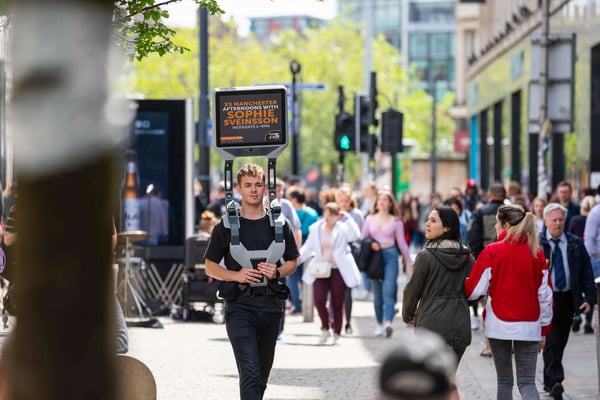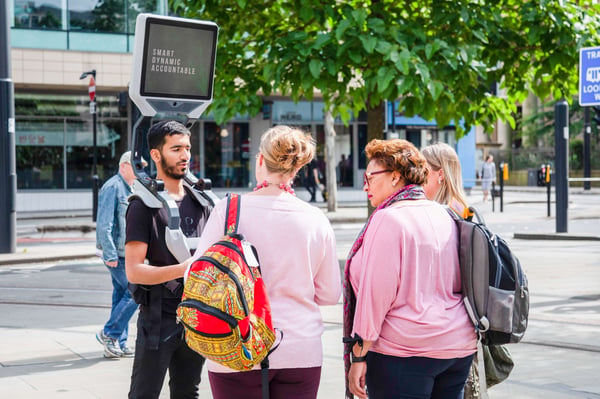The digital revolution of out of home media has spurred on new programmatic conversations and exciting opportunities for advertisers looking for more accountability from their advertising.
The rise of programmatic is helping out-of-home to become more targeted. Through its Digital Audio Exchange (DAX) platform, Global, owner of radio stations including Capital and Heart, recently worked with energy brand E.ON to set up geo-fencing around out-of-home sites.
“Programmatic isn’t purely about the automation of our processes – it’s about connecting brands more effectively with their audiences by allowing them to deliver the right message to the right audience at the right time,”
- Cadi Jones, commercial innovation director at Clear Channel
The technology enabled E.ON to identify when someone walked into one of the geo-fenced zones so when they later listened to digital radio or streamed music via their mobile device they were served an E.ON audio ad that mirrored the outdoor poster they’d already seen.
Adding the digital audio element to the out-of-home campaign increased consideration for the brand by 26%, while people exposed to both the outdoor activity and audio ads were 31% more likely to recommend E.ON. These same people were also four times more likely to sign up for a smart meter – the main objective of the activity – when visiting the energy firm’s website compared to average site traffic.
This article will dive into how programmatic digital out of home advertising is evolving and how it can tie together your online and offline advertising.
Moving Beyond Awareness
Total Transparency and Accountability
More Sophisticated Storytelling
Moving Beyond Awareness
When you think of outdoor advertising you think of big impact media that is great for raising awareness and amplifying conversations around brands, but, with the rise of digital and programmatic integration into digital out of home technology, advertisers are starting to pay attention to out of home's ability to drive purchase consideration and intent.

In July, Sony marked the release of Ghostbusters with a takeover of London’s Waterloo station, centred on a giant installation of the film’s Stay Puft Marshmallow Man character emerging from the ground. Waterloo was chosen for its footfall and scale. The station was adorned with ectoplasm, ticket barrier branding and a wrap of the Underground station. Collaborating with JCDecaux, screens showed spoof news footage, while a pop-up shop offered Ghostbusters merchandise and Odeon representatives sold film tickets.
Instead of a simple awareness drive, the takeover aimed to push the concept further, explains Sony Pictures deputy managing director and marketing director Stuart Williams. “We wanted an integrated experiential outdoor element that worked on a number of levels. We always look at how to ‘eventise’ a film and be part of the zeitgeist, and the scale of this installation allowed us to do that. We were trying to give a nod back to the original film with the iconic Stay Puft character, but with a new spin.”
It was that integration that took this out of home campaign beyond awareness and towards conversion.
With opportunities for viewers to download their own Ghostbusters snapchat filter ( a shrewd move considering people who see an ooh campaign are 17% more likely to engage with a brand on their mobile. ) this out of home campaign drove viewers across channels.
More recently we've seen our own inventory deployed to events in exciting ways that do more than simply amplify a presence at an event.

Case Study: Manchester Duck Race
Smooth Radio North West's 5 year long partnership with the Manchester Duck Race has helped position the Duck Race as one of the Cities stand out events.
Smooth's presence at the event is traditionally quite standard with the usual suspects including banners, street team, games and competitions surprising absolutely no one.
Manchester Duck Race 2019 marked the change for Smooth as they moved away from simply being there to gaining an insight into how people attending the event engaged with their brand and how effective the partnership really was. This year, Smooth wanted to use the Duck Race as an opportunity to boost sign ups to one of their upcoming events.
Deployed alongside the regular branding was the iWalker which revolutionised Smooth's presence at the Duck Race in a number of ways.

Facial Detection
Advertising are always looking for accountability from their marketing spend and it's no different with out of home advertising.
As with all traditional advertising mediums, out of home struggles to report on it's own effectiveness. Who was looking? How many people actually saw your ad? How many of those people looked instead of just glancing?
Well, Smooth Radio North West removed this blind spot by using the iWalker's facial detection software delivered through a front-facing camera on the iWalker frame.
Profile's on 'watchers' were built and split into 4 different and distinct demographic groups. Data was gathered on key metrics like time spent viewing and was built into a live report in Quividi.
Dynamic Content Management (Signage Live)
Big events like the Manchester Duck Race will have a full itinerary of different activities and events throughout the day and an advertiser who can be dynamic, changing their message and content to match the itinerary of the event will enjoy the benefit of relevancy and context.
That's exactly what Smooth Radio North West were able to achieve through their use of the iWalker which is supported by Signage Live.
Through Signage Live, Smooth Radio North West were able to 'hot-swap' content within seconds, meaning they could keep up with the busy itinerary and stay relevant throughout the day.
In previous years, Engagements and sign ups to the event have dipped as the Duck Race goes on, but with the deployment of the iWalker and use of dynamic content changes, sign-ups remained consistently high.
Total Transparency and Accountability
Advertisers have always looked for accountability from their advertising.
From traditional post-campaign analysis to the more modern, end to end, live reporting that paid search and paid social has provided, advertisers are now armed with more ways to judge the effectiveness of their advertising campaign than ever.
And with the digital renaissance of out of home media, total transparency and accountability are within reach.
The importance of accurate audience measurement data becomes glaring as the focal point of campaign planning shifts away from buying media spots and towards buying target audiences. When planning a campaign certain questions are critical to ensuring successful delivery - “who are we speaking to?”, “what do they want to know?” and “where and when do we reach them?”. With reliable audience measurement data, as well as standardised data formats, we can be sure that we have the foundations to answer these questions and plan effective and efficient campaigns.
Most marketers understand that OOH works, but measuring its effectiveness has historically been a challenge. Until recently, buyers manually converted OOH inventory metrics to more standardized impressions, a time-consuming process that was often inaccurate.
Measurement is one of the main advances digital brought to the OOH advertising medium, and with location and time data, advertisers now have the ability to track consumer movement in the real world, such as in-store foot traffic.
More Sophisticated Storytelling

GSK has launched the UK’s first end-to-end, fully automated digital out-of-home (OOH) campaign trade for its Piri allergy relief products.
The campaign is fully programmatic from planning through to purchase of out-of-home inventory and uses specific event-based triggers such as MET Pollen Data, location criteria and spending parameters to determine which ads will appear when and where.
Devised by Publicis Media’s PlatformGSK, the campaign will be activated by out-of-home and location marketing specialist Posterscope using its proprietary global data management platform ECOS.
Pollen data by region will be pulled in automatically from the MET office and when it reaches the defined “high” or “very high” trigger levels in any given region, the ECOS platform will automatically request availability across a portfolio of sites, purchase only when spend criteria is met, and automatically serve the relevant ads at the optimum time.
The campaign goes live at the end of May and will run nationwide, on rail and roadside D6’s until the end of August.
James Carpenter, brand manager at GSK said: “Innovation is a key value for GSK, so we asked PlatformGSK to find a way to represent this in our out of home execution. We weren’t disappointed. This flexible and fully automated approach will provide a guaranteed out of home presence for our Piri product range throughout the summer, but specifically in the moments when pollen levels reach their highest and customers are looking for hay fever relief.”
Charlotte Jackson, managing partner PlatformGSK, said: “Data and technology sit at the heart of PlatformGSK’s approach, so we are delighted to bring the UK’s first truly programmatic outdoor campaign to market. We take an outcome-based planning approach and to be able to track, adjust and optimise in real time will ensure that we get the maximum value and effect from this innovative campaign.”
The campaign is fully programmatic from planning through to purchase of out-of-home inventory and uses specific event-based triggers such as MET Pollen Data, location criteria and spending parameters to determine which ads will appear when and where.


